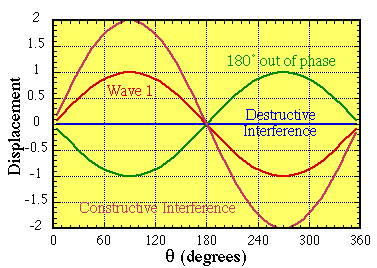

Interference results from the superposition of waves. When two waves with the same frequency and amplitude overlap, the result is a wave with the same frequency and twice the amplitude. These two waves are in phase and interfere constructively. If the two waves are 180° out of phase, the amplitude of the resulting wave is zero. This situation is called destructive interference.
In the figure above, assuming two waves like Wave 1 are superimposed results in constructive interference. Note that constructive interference results in a wave with twice the amplitude. Superimposing Wave 1 and the wave labeled "180° out of phase" results in destructive interference. This wave has zero amplitude but still exists.
© MultiMedia Physics 2000